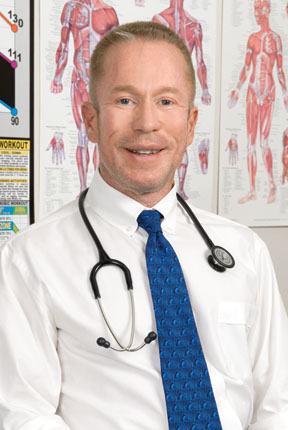

News and Info > Steroids Article
Steroids: The Facts Behind The Hype
By Jeffrey S. Dunham, M.D., Ph.D., M.P.H.
There has been a lot in the news lately regarding steroid use among professional athletes–congressional investigations, tell-all books, baseball players in tears testifying that they never meant to hurt anybody. With all the hype you’d think that testosterone and human growth hormone (HGH, which, by the way, is not a steroid but is often talked about with other steroids) are illegal drugs like heroin. The fact is that they are perfectly legal when prescribed by a physician for the appropriate reason. When Howard Stern recently asked Jose Canseco if he was still “juicing,” his response was “I’m not taking any illegal drugs.” Translation: I now get testosterone and growth hormone through my physician. What’s illegal about these drugs are not the drugs themselves, but their purchase and use without a physician’s prescription, just as it would be illegal to obtain and take Lipitor or Vicodin without a prescription.
The irony in all of this is that Barry Bonds, Mark McGuire, and Jose Canseco could probably have obtained testosterone and HGH from their personal physicians, if, like many men over 40, their levels are low. Testosterone (and HGH) therapy is safe and can provide dramatic benefits for men whose levels have decreased with age (virtually all men over 40). What people don’t understand is that the testosterone and growth hormone levels in men at age 50 are about half of what they were at age 25; at age 80 the levels can be one-tenth of what they were at age 25. What anti-aging and other progressive physicians do is replace these hormones to the levels they were when the patient was approximately 25 years old, no more, no less.
This is in sharp contrast to the doses used by competitive bodybuilders who take supraphysiological doses, which may be as high as 10 times more than the upper limit for a 25 year old-male. Bodybuilders will develop massive musculature from this dose and will be at risk for a number of side effects; patients receiving testosterone replacement monitored by their physician will develop a more youthful appearing physique (more muscle and less fat), have more energy, have a dramatically increased libido and sexual function, have increased effectiveness of their workouts, and, in general, feel more like they did when they were 25, with virtually no side effects. The reason for this is that their bodies have experienced this level before, albeit 20 or 30 years ago, so the therapy is more natural or “holistic” than taking bags of supplements that may contain chemicals the body has never seen before.
So what exactly is testosterone and what does it do? Testosterone is probably the most important hormone in men for overall quality of life, and the most important hormone in women for determining their libido. It is made in the testes and adrenal glands from a precursor molecule that looks much like cholesterol, and binds to receptors in tissues throughout the body (muscle, bone, brain, etc.). Part of this testosterone is naturally converted in the body to estradiol (the female hormone). Both men and women need testosterone and estradiol; it is the ratio of these two hormones in the body that makes men masculine and women feminine. One of the problems in men as they age is that less testosterone is made, and more of the little that is made is converted to estradiol. This can be accelerated even more in men with excess body fat, since fat cells produce even more estradiol. Have you ever seen an older, obese male who looks like he could just as well be an older, obese female?
You cannot grow muscle without testosterone. This is why women, who typically have a much lower level of testosterone than men, will not develop huge muscles no matter how hard they work out, unless they take testosterone or testosterone-like drugs (which is exactly what most professional female bodybuilders do). You cannot have a libido without testosterone. A man with very low levels of testosterone will be pale, depressed, have a large belly, skinny extremities, low energy and sex drive, decreased sexual functioning, stiffness and pain in muscles and joints, a general lack of vitality and zest for life, and virtually no “scent.” As a French endocrinologist once said to me, “It is impossible to fall in love with such a man.” This is not a good way to live the last half of your life.
So why are so many people against using testosterone? Probably because they don’t know the facts. The only problem with testosterone supplementation is when young athletes take extreme doses to gain an athletic advantage. If you’re 25 and already have the testosterone levels of a 25 year old, you shouldn’t be taking any more. The other problem is that people confuse testosterone (the natural hormone) with the other chemically modified testosterone-like steroids. These drugs may have some of the properties of testosterone (muscle-building, etc.), but cause problems because they’re chemicals that are completely foreign to the human body. Generally, any testosterone-like steroid you can take by mouth has been chemically modified to survive the stomach acids and modification by the liver, and has the potential to cause a multitude of problems.
People also talk about all the side effects of testosterone supplementation. But just what are the facts? In 2004, the New England Journal of Medicine, the most prestigious and respected medical journal in the world, published a review about testosterone replacement. The conclusions were that there was no evidence of prostate problems or cancer, no evidence of liver toxicity (remember, this is the hormone administered by injection or a transdermal cream), no change in cholesterol or triglycerides, and a possible beneficial effect with respect to the prevention of cardiovascular disease. The only possible adverse effects were an increased number of red blood cells (which can be easily monitored and treated), an infrequent incidence of acne, sleep apnea, and gynecomastia (the development of breasts in the male which can be easily treated by blocking the conversion of testosterone to estradiol), and mild testicular atrophy in younger men, which is reversible with cessation of treatment.
So what do the experts recommend for monitoring testosterone replacement? The first point is that patients need to see their physician and have a baseline medical history and physical exam (including a digital rectal exam). They also need to have blood tests for base-line testosterone levels, prostate-specific antigen (PSA), and hematocrit (a measure of the number of red blood cells). An efficacy evaluation and dosage adjustment should be done in 1 to 2 months, and then a monitoring evaluation every 3 to 6 months thereafter.
Is testosterone therapy expensive? Because testosterone is a natural hormone that cannot be patented by a drug company, it is relatively inexpensive.. There are some patented delivery systems (e.g., Androgel- which is only a 1% gel and relatively expensive since one generally needs about 4 or 5 packets a day to achieve optimal levels), but compounding pharmacies can prepare up to 20% testosterone transdermal creams which get the cost down to about $1 per day.
If you think you may be experiencing the symptoms of low testosterone levels (low energy, fatigue, depression, decreased libido, increased belly fat), ask your doctor to check your testosterone level. If it comes back and your doctor says it’s normal for your age, make sure you tell him that you don’t want to have the normal level of a 50 year-old man, but would like to achieve the levels you had when you were 25. If he balks at this request, see a more progressive physician. Remember, it’s your quality of life that we’re talking about, and it’s much more enjoyable to experience life with a testosterone level of 800, rather than 200. When you start experiencing the morning erections that you forgot you used to get 20 years ago, you’ll understand what I’m talking about.

